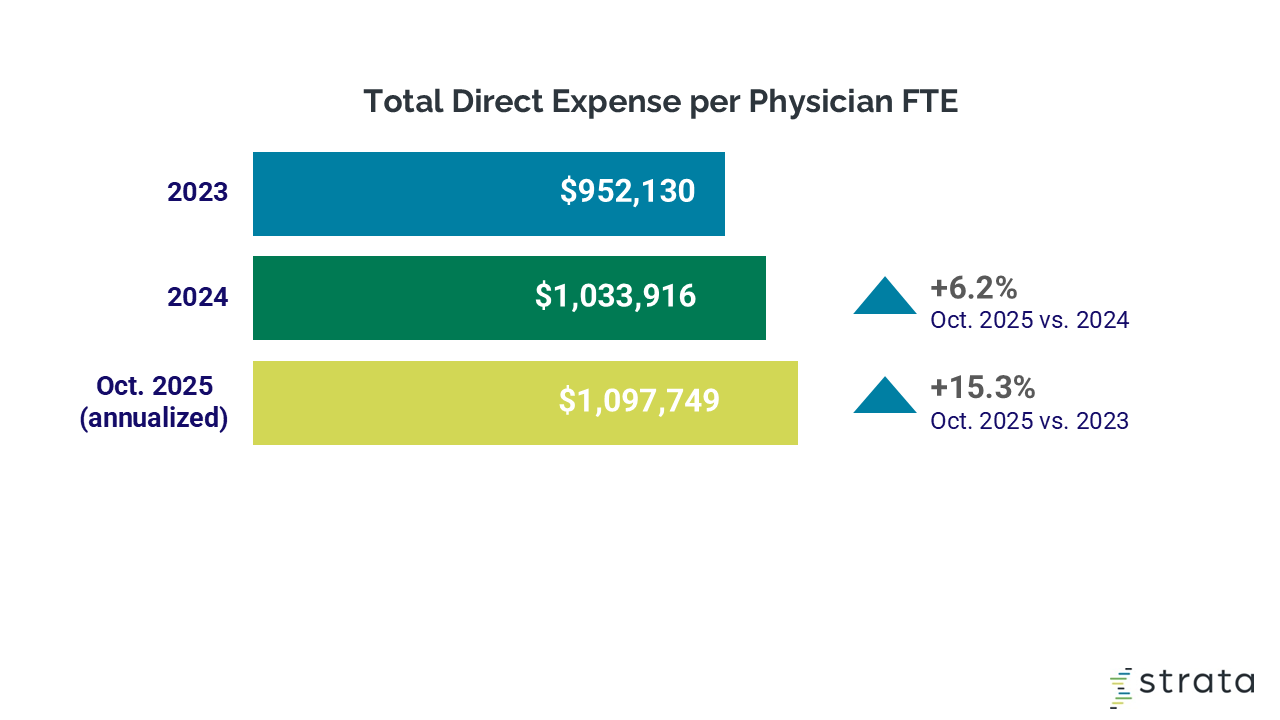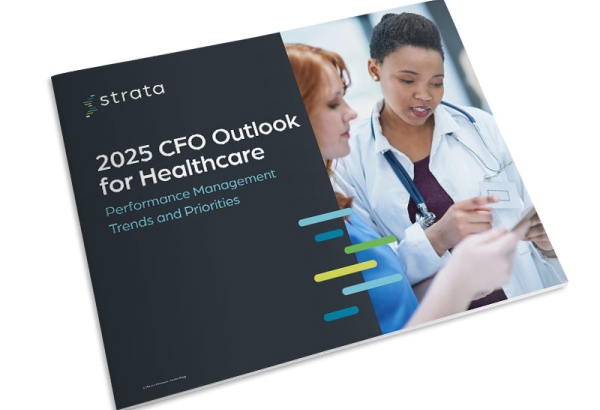Monthly Healthcare Industry Financial Benchmarks
October’s Hospital, Patient Volumes, and Physician Practice Financial Performance


This report highlights the latest trends in financial performance for U.S. hospitals and physician groups, drawn from monthly data from more than 135,000 physicians and over 1,900 hospitals.
Despite increases in revenues and shifting patient volumes, elevated hospital and physician practice expenses continued to limit the degree of margin improvement in October. Highlights from the October 2025 data include:
Median health system operating margins remained narrow but edged up to 1.2% in October, marking their highest level of 2025 and the third consecutive monthly increase.
Hospital expenses continued to rise in October, but at a slower pace than September’s double-digit gains, with supply expenses posting the largest year-over-year increase at 9.2%.
Patient volumes showed modest growth, as outpatient visits increased 2.8% and inpatient admissions rose 1.5% from October 2024 to October 2025.
Hospitals saw continued strength in outpatient revenues, with gross outpatient revenue up 10.0% year over year, outpacing inpatient revenue growth of 6.8% over the same period.
Physician expenses also climbed, with the median total expense per physician reaching approximately $1.1 million for October annualized, up 6.2% year over year.
The latest benchmarks illustrate the interplay of revenues and expenses on historically tight hospital operating margins.

Operating Margins: Margins for the nation’s health systems continued to inch upward, with the median year-to-date (YTD) operating margin rising from 1.1% in September to 1.2% in October. While still narrow, the uptick put health system operating margins at their highest point so far in 2025. The metric has seen little movement, remaining close to 1.0% throughout the year.
Margin changes also remained minimal for U.S. hospitals. The median change in hospital operating margin was nearly flat, rising just 0.2 percentage point year-over-year (YOY) in October and up just 0.5 percentage point from September to October 2025.
Performance varied across census regions. Median YOY changes in operating margin ranged from modest gains of 1.1 percentage points for hospitals in both the Northeast and South to an 0.8 percentage-point decline for hospitals in the Midwest. Hospitals in the West experienced the steepest decline, with median operating margins down 1.3 percentage points YOY.
Operating margin trends also differed by hospital size. The smallest hospitals (0–25 beds) saw the only decrease, with margins down 1.9 percentage points YOY. Among mid-sized facilities, YOY increases ranged from 0.6 percentage point for hospitals with 26–99 beds to 1.5 percentage points for those with 200–299 beds. Hospitals with 300–499 beds saw no change YOY, while the largest hospitals (500+ beds) reported a 0.5 percentage-point increase.
For hospitals nationally, the median change in operating earnings before interest, taxes, depreciation, and amortization (EBITDA) margin decreased slightly 0.1 percentage point YOY but increased 0.4 percentage point month over month.
Hospital Expenses: Overall hospital expenses rose across all categories compared to 2024 levels, with non-labor expense increases again outpacing labor expense growth. Total non-labor expense increased 8.8% YOY, compared to a 4.2% rise in total labor expense. Overall, total hospital expenses were up 7.0% from October 2024 to October 2025.
The growth in non-labor expenses was driven by a 9.2% YOY increase in supply expenses, an 8.4% YOY rise in drug expenses, and a 6.9% YOY increase in purchased service expenses. Regional trends showed notable variation. Looking specifically at supply expenses, hospitals in the West experienced the steepest YOY increase at 10.4%. Hospitals in the South saw the next largest rise at 9.7%, while hospitals in the Midwest and Northeast reported increases of 7.6% and 7.5% YOY, respectively.
At the national level, hospitals also saw expenses rise month over month. Total expense increased 3.5% from September to October, driven by 3.4% increases in both total labor and total non-labor expenses. Supply and drug expenses saw sizable month-over-month growth, rising 6.3% and 5.1%, respectively.
Expense results were mixed after adjusting for patient volumes. Total expense per adjusted discharge rose 3.7% YOY, driven by a 5.5% YOY increase in non-labor expense per adjusted discharge. Labor expense per adjusted discharge, however, edged down slightly by 0.2% over the same period.
Hospital Revenues: Hospitals continued to see gross revenues rise above 2024 levels in October. Gross operating revenue increased 8.9% YOY, supported by a 10.0% rise in outpatient revenue and a 6.8% increase in inpatient revenue. Month over month, gross operating revenue climbed 5.3%, with outpatient revenue up 6.4% and inpatient revenue rising 3.9%.
Outpatient revenue growth remained strong across all census regions. Hospitals in the Northeast saw the largest YOY increase at 13.2%, followed by hospitals in the South at 10.4%. Outpatient revenue also rose 9.8% for hospitals in the West and 9.2% for those in the Midwest.
Revenue results were mixed on a per-patient basis. Net patient service revenue (NPSR) per adjusted discharge was up 3.3% YOY but declined 2.3% month over month, while NPSR per adjusted patient day increased 4.6% YOY and 0.3% month over month. At the same time, hospitals continued to see increases in unpaid care. Bad debt and charity care increased 5.3% YOY and rose 1.0% month over month in October.


Get an in-depth look at current healthcare trends with analyses of financial, operational, and claims data from organizations nationwide, with insights drawn from all of Strata’s datasets.
Hospital inpatient and outpatient volumes are drawn from analysis of more than 10 million patient visits.

Hospital volumes: Hospitals continued to see mixed results in patient demand in October. Outpatient visits remained the strongest area of growth nationally, increasing 2.8% YOY. Inpatient admissions rose 1.5% compared to October 2024, while observation visits decreased 1.9% and emergency visits dropped 5.2%.
Looking at month-over-month changes, outpatient visits jumped 6.4% from September to October, while inpatient admissions rose just 0.6%. Emergency visits saw the largest drop, down 6.0% month over month, followed by observation visits which decreased 1.2%.
Regional variation persisted across the country. Hospitals in the Midwest saw the largest YOY increase in outpatient visits at 4.9%, followed by the West at 4.2%. Hospitals in the West recorded the biggest growth in inpatient admissions, up 3.7% YOY, followed by those in the Northeast at 3.6%. Compared to October 2023, outpatient visits nationally increased 13.6%, while inpatient admissions rose 5.4%.
Service line volumes: Patient demand increased across most service lines in September, with the most significant YOY increases appearing in ophthalmology (+15.7%), hepatology (+14.4%), and hematology (12.9%). Patient volumes for the cancer service line rose 11.0% YOY. On the other end of the spectrum, infectious disease was among the only service lines to see patient volumes decline, decreasing 6.3% YOY.
Procedure volumes: Among 15 common procedure types, declines remained concentrated in a few areas. Inpatient primary knee replacements saw the largest YOY decrease at 6.2%, illustrating the continued migration of such procedures from inpatient to outpatient settings.
Inpatient primary hip replacements decreased 1.3% YOY and outpatient microbiology lab procedures were down 1.8%. The strongest growth continued to come from outpatient positron emission tomography (PET) imaging, which posted a 23.7% YOY increase, followed by outpatient upper gastrointestinal endoscopies with an increase of 20.4% YOY. Outpatient magnetic resonance imaging (MRI) imaging and outpatient computed tomography (CT) imaging also saw notable gains at 16.1% and 13.9%, respectively.
Children’s hospital volumes: Children’s hospitals continued to see mixed patient demand at the start of the fourth quarter in October. Outpatient visits increased 0.9% YOY, while inpatient admissions declined 4.4%. Observation visits rose 1.6% compared to October 2024, and emergency visits saw the largest drop, down 9.3% YOY.
![]()

A look at last month’s key performance indicators from more than 10,000 physician practices.

Physician investments: Physician practices saw the level of investment required to support operations rise for October annualized. The median investment per physician full-time equivalent (FTE) reached $312,050, an increase of 3.2% compared to 2024 and 15.2% versus 2023.
Across census regions, October annualized results showed increases in most areas. Practices in the Northeast experienced the largest jump compared to 2024, with median investment per physician FTE up 7.8%. The metric increased 1.9% for practices in the Midwest and 1.6% for those in the South. The West was the only region to see a slight decline versus 2024, with investment levels down 0.7%. Compared to 2023, however, all regions saw notable increases, ranging from 2.2% in the Midwest to 24.2% in the South.
Physician expenses: Physician practices also saw expenses continue to rise. The median total expense per physician FTE was $1.1 million for October annualized, up 6.2% compared to 2024 and 15.3% versus 2023 levels.
Expenses increased for practices across all regions. Practices in the Midwest saw the largest YOY increase, with total expense per physician FTE up 9.8%, followed by the South at 5.3%. The metric rose 4.9% YOY for practices in the Northeast and was nearly flat — up just 0.1% — for those in the West.
Physician revenues: Physician revenues continued to increase. The median net patient service revenue (NPSR) per physician FTE reached $773,726 for October annualized, an increase of 4.7% compared to 2024 and 13.9% versus 2023.
Regional results showed varied growth. Practices in the West saw the largest YOY increase at 6.5%, followed by those in the South at 5.9%. The metric also rose 3.1% YOY for practices in the Midwest, but dropped 7.4% YOY for those in the Northeast. Compared to 2023, all regions experienced increases ranging from 5.1% in the Northeast to 20.5% in the West.
Physician productivity and staffing: Physician productivity increased in October while staffing levels declined. The median work relative value units (wRVUs) per physician FTE reached 6,238 for the month annualized, up 1.3% compared to 2024 and 6.6% above 2023 levels. At the same time, staffing levels continued to trend downward. Median support staff FTEs per 10,000 wRVUs — a measure of staffing levels and productivity — was 3.5, down 1.8% versus 2024 and down 4.1% compared to 2023.



